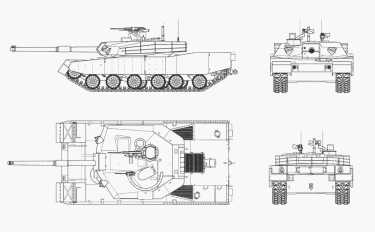



The Hyundai K1 is the first main battle tank designed and built domestically in South Korea, providing a significant increase in capability from the ROK Army's previous front-line tank, the M48 (which by the 1980s was outclassed by North Korean T-62s). The K1 was inspired by the M1 Abrams, and its design strongly resembles its US counterpart in both the turret and hull design. It shares many components, including Chobham armor, as well as the M1's original 105-mm M68 rifled gun, which was later upgraded to a locally-built 120-mm KM256 smoothbore. Layout is conventional but equipment and components are sourced from numerous external suppliers (mostly US and French electronic equipment, and a German diesel engine) of which some are license-built domestically. A key difference with the M1 is the suspension which is a hybrid system of hydroneumatic units and torsion bars, allowing the tank to kneel in order to improve the gun's depression. An NBC system is also included, and the tank has superior fording capability than the M1. Since its introduction in the 1980s, the K1 has gradually replaced the older M48s in front-line service. However, it too is now being complemented by the newer K2. No export orders have been undertaken despite initial interest by Malaysia.
The first XK-1 prototypes were completed in 1983, entering production as the K1 in 1985. The initial variant was equipped with a 105-mm gun. A major upgrade resulted in the K1A1, which aside from featuring a more powerful 120-mm KM256 smoothbore, featured numerous mechanical improvements along with an enhanced ballistic computer and night combat capability. Most recently, the K1A2 was developed, featuring some of the technology from the K2 tank. A soft-kill active protection system is provided for defense against ATGMs and RPGs. Upgrades of existing K1 and K1A1s to this new standard are being undertaken. The only non-tank variant is the K1 ARV armored recovery vehicle, built in colaboration with Rheinmetall (Germany).
 |  | |
| Design | K1 | K1A1 |
| Type | Main Battle Tank | Main Battle Tank |
| Year | 1985 | 1999 |
| Crew | 4 | 4 |
| Dimensions | ||
| Length (w/Gun) | 24 ft 6 in (31 ft 9 in) | 24 ft 6 in (31 ft 10½ in) |
| Width | 11 ft 9 in | 11 ft 9 in |
| Height | 7 ft 5 in | 7 ft 5 in |
| Ground Clearance | 0 ft 0 in | 0 ft 0 in |
| Track | 0 ft 0½ in | 0 ft 0½ in |
| Track on Ground | 0 ft 0½ in | 0 ft 0½ in |
| Weight | ||
| Combat | 112,656 lbs | 117,286 lbs |
| Ground Pressure | 12.37 psi | 0 psi |
| Suspension | Hybrid | Hybrid |
| Performance | ||
| Speed (Off-Road) | 40 mph | 40 mph |
| Range (Off-Road) | - | - |
| Amphibious | No | No |
| Fording | 4 ft 11 in (7 ft 3 in) | 4 ft 11 in (9 ft 12 in) |
| Vertical Obstacle | 3 ft 3 in | 3 ft 3 in |
| Trench | 9 ft 12 in | 9 ft 12 in |
| Gradient | 60% | 60% |
| Powerplant | ||
| Engine | 1 x 1,200-hp MTU MB 871 Ka-501 | 1 x 1,200-hp MTU MB 871 Ka-501 |
| Fuel | Diesel | Diesel |
| Power/Weight | 23.48 hp/t | 22.56 hp/t |
| Armament | ||
| Main | 1 x 105-mm L/52KM68A1Rifled Gun↑ 20° / ↓ -10° / ↔ 360° | 1 x 120-mm L/44KM256Smoothbore Gun↑ 20° / ↓ -10° / ↔ 360° |
| Secondary | None | None |
| Armor | ||
| Type | Composite | Composite |
| Thickness | 480 - 520 mm | 720 - 750 mm |
| Max Effective | 480 - 520 mm RHAe | 720 - 750 mm RHAe |
| Hull Upper Front | 480 mm | 720 mm |
| Turret Front | 520 mm | 750 mm |
| Production | ||
| Built | 1,027 | 484 |
| Total | 1,511 |